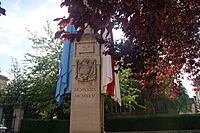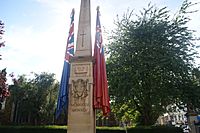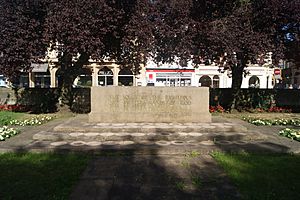Northampton War Memorial facts for kids
Quick facts for kids Northampton War Memorial |
|
|---|---|
| United Kingdom | |
 |
|
| For servicemen from Northamptonshire killed in the First and Second World Wars | |
| Unveiled | 1926 |
| Location | 52°14′14″N 00°53′45″W / 52.23722°N 0.89583°W Wood Hill, Northampton, England
|
| Designed by | Sir Edwin Lutyens |
|
Listed Building – Grade I
|
|
| Official name | The Town and County War Memorial |
| Designated | 22 January 1976 |
| Reference no. | 1191327 |
The Northampton War Memorial, also known as the Town and County War Memorial, is a special monument in Northampton, England. It stands on Wood Hill and remembers the brave soldiers from Northamptonshire who died in the First World War and Second World War.
This memorial was designed by a famous architect named Sir Edwin Lutyens. It features a large stone called the Stone of Remembrance. On either side of this stone are two tall, pointed pillars called obelisks. These pillars have stone flags painted on them. The memorial is set in a small garden that used to be part of All Saints' Church's churchyard.
People in Northampton started talking about a war memorial soon after the First World War ended in 1918. For a while, a temporary wooden memorial stood in Abington Street. Sir Edwin Lutyens was asked to design the permanent one. His design was approved quickly, but it took six years to build. This was because the land had to be bought from the church, which needed special permission. The memorial was finally shown to the public on 11 November 1926. A big ceremony took place, with local schoolchildren and town leaders attending.
Northampton's memorial is one of the most detailed town memorials in England. It uses three special features that Sir Edwin Lutyens often included in his designs: two obelisks, the Stone of Remembrance, and painted stone flags. The painted flags were not used on his famous Cenotaph in London, but they appear on several of his other memorials. Today, this memorial is a Grade I listed building. This means it is a very important historical site. It was given this high status in 2015 because Lutyens's war memorials were recognized as a "national collection."
Contents
Why War Memorials Are Important
The First World War caused a huge number of deaths. Almost every town and village in Northamptonshire lost men in the war. Only two villages, East Carlton and Woodend, did not lose anyone. After the war, thousands of memorials were built across Britain to remember those who died.
One of the most important designers of these memorials was Sir Edwin Lutyens. He was known as a leading English architect of his time. Before the war, Lutyens designed grand country houses. After the war, he spent much of his time creating memorials for the fallen. He worked for the Imperial War Graves Commission (now the Commonwealth War Graves Commission). He designed many war memorials for towns and villages in Britain and other countries.
Lutyens also designed The Cenotaph in London, which is now the main place for national remembrance services. He created the Thiepval Memorial to the Missing, the largest British war memorial in the world. He also designed the Stone of Remembrance, which is found in all large Commonwealth War Graves Commission cemeteries. This stone is also a key part of many town memorials, including the one in Northampton.
How the Memorial Was Built
Northampton's first war memorial was a temporary one. It was made of wood and plaster and stood in Abington Street from July 1919. This temporary memorial was used for remembrance services until the permanent one was ready. People in Northampton discussed what kind of memorial they wanted. Some thought it should be a monument, while others wanted it to be a building for the community, like a concert hall.
The Northamptonshire War Memorial Committee decided to build a monument just for remembering the fallen. They chose a spot in the churchyard of All Saints' Church. The money for the memorial came from public donations.
Lutyens finished his designs by 1920, and they were approved that November. However, the chosen site was part of a churchyard, and some graves had to be moved. This meant the committee needed special permission, called a faculty, from the Diocese of Peterborough. This caused a delay. Construction finally began in 1926, six years after the designs were ready. By July 1926, local newspapers reported that the obelisks were carved and waiting for the flags to be painted.
What the Memorial Looks Like
Northampton's war memorial is quite grand, especially for a town. It has a Stone of Remembrance in the middle, with two tall obelisks on either side. Each obelisk has two painted stone flags. The use of obelisks, the Stone of Remembrance, and painted flags makes it a very important example of Lutyens's work.
Each obelisk stands on a tall, rectangular column with four steps. This column sits on a wider, square base. The obelisks and their columns are richly decorated. A narrow cross is carved into the obelisks. The town's coat of arms is shaped onto the columns. The columns also have deep decorative niches, which look like arches under the obelisks.
Obelisks appear in several of Lutyens's memorials. However, only Northampton's and Manchester's use a pair of obelisks on either side of the main monument. These designs are considered very beautiful. The obelisks have the dates of the First and Second World Wars carved in Roman numerals. The Second World War dates were added later.
Two stone flags appear to hang from each obelisk. They are painted to look like the Union Flag (the British flag), the White Ensign (Royal Navy flag), the Red Ensign (Merchant Navy flag), and the RAF Ensign (Royal Air Force flag). Each flag has gold wreaths above it. Lutyens first wanted to use stone flags for the Cenotaph in London, but they chose fabric flags instead. However, he used stone flags on other memorials, like the Rochdale Cenotaph.
The Stone of Remembrance is carved from a single piece of rock. It is about 12 feet (3.7 meters) long and has no decoration other than its inscriptions. What's special is that it has inscriptions on both sides. The east side says: "THEIR NAME LIVETH / FOR EVERMORE." This phrase was suggested by Rudyard Kipling and comes from a Bible verse. The west side says: "THE SOULS OF THE RIGHTEOUS / ARE IN THE HANDS OF GOD," which comes from another ancient text.
The whole memorial stands on a stone platform. The Stone of Remembrance is raised even higher on three stone steps. The memorial is in a small garden, which is now just outside the churchyard. A low stone wall is at the front, and a yew hedge is at the back. There are decorative gates on either side. These gates are made of cast iron and are supported by large stone pillars with urn-shaped tops. The wall has an inscription that says: "TO THE MEMORY OF ALL THOSE OF THIS TOWN AND COUNTY WHO SERVED AND DIED IN THE GREAT WAR."
History of the Memorial
The Northampton War Memorial was finally unveiled on 11 November (which is Armistice Day) 1926. A very large church service took place, with 5,000 local schoolchildren attending. So many people came that the service had to be held in the market square instead of the church. After the service, the crowd walked to the new memorial. The parade was led by veterans from the Battle of Mons and included other military members, nurses, and town leaders.
General Henry Horne, 1st Baron Horne officially unveiled the memorial. The Reverend Norman Lang, a bishop, dedicated it. General Horne said that it was important for Northampton, as the county town, to have a visible monument. He felt it would remind everyone of the bravery and sacrifice of the men from Northamptonshire. The Prince of Wales (who later became King Edward VIII) laid a wreath at the memorial on 7 July 1927.
The Town and County War Memorial does not list the names of those who died. Because of this, the local branch of the Royal British Legion wanted a separate memorial with names. A garden of remembrance was built in Abington Square, where the temporary memorial used to be. This garden was opened in 1937, and the names of the fallen were carved onto its walls. A memorial to Edgar Mobbs, a famous rugby player from Northampton who died in the First World War, was also moved into this garden.
The Northampton War Memorial was first recognized as a Grade II* listed building on 22 January 1976. In November 2015, during the 100th anniversary of the First World War, Lutyens's war memorials were called a "national collection." All 44 of his memorials in England had their status reviewed. As part of this, the Northampton War Memorial was upgraded to Grade I, showing its great historical importance.





